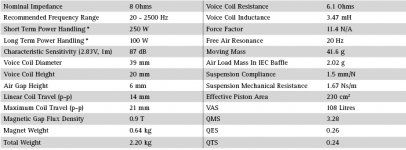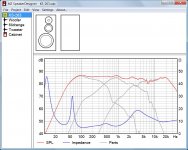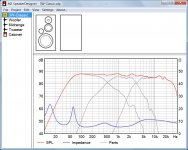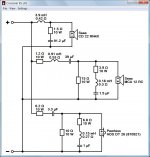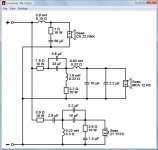Hi y'all,
Does anyone here have the expertise as to guess why he didn't use this driver?
I would ask him but he won't talk to me anymore.
And if your guess is as good as mine,could one use it instead of the prescribed original,
if so what would that mean to the bass circuit?
The best Mo0
Does anyone here have the expertise as to guess why he didn't use this driver?
I would ask him but he won't talk to me anymore.
And if your guess is as good as mine,could one use it instead of the prescribed original,
if so what would that mean to the bass circuit?
The best Mo0
Attachments
Forgot the driver number CD22RN4X
Pete doesn't the much lower Fs justify the difference
of only 11 ltrs. compared to the CA22RNX ?
Pete doesn't the much lower Fs justify the difference
of only 11 ltrs. compared to the CA22RNX ?
the critical factor is the Qts, .24 is very low..
sim them both in Unibox & see how different they are
sim them both in Unibox & see how different they are
CD22RN4X has Le=3.47mH and Mms=42g and Qts=0.24. ICK
The 8" SBacoustics SB23NRX45 has Le=0.6mH and Mms=27g and Qts=0.38 (ideal for ported). Great for Xover to 4" midrange.
==SB Acoustics 3 ways ==one = $177
1" B26STC-C000-4 $33
4” SB12MNRX25-4 $51
5" SB15NRXC30-8 $52
8'' SB23NRXS45-8 $92
The 8" SBacoustics SB23NRX45 has Le=0.6mH and Mms=27g and Qts=0.38 (ideal for ported). Great for Xover to 4" midrange.
==SB Acoustics 3 ways ==one = $177
1" B26STC-C000-4 $33
4” SB12MNRX25-4 $51
5" SB15NRXC30-8 $52
8'' SB23NRXS45-8 $92
There are more problems with the CD22 than just the enclosure size.
-The CD22 has a massive shelf in the response at 600Hz. There is probably also a nasty cone resonance to go with it.
At least the CA22 has a generally rising response which is easy to correct in the crossover. The CD22 would require much more crossover work to hammer into an acceptable response for the ~580Hz crossover that the classic 8 uses.
-The CD22 is much less sensitive (2.5dB SPL) than the CA22 which would require the entire crossover to be reworked to bring the mid and tweeter down to similar levels. Troels also seems to be a fan of light weight high-sensitivity drivers which explains the choice of the CA22 in the first place.
-The CD22 has a massive shelf in the response at 600Hz. There is probably also a nasty cone resonance to go with it.
At least the CA22 has a generally rising response which is easy to correct in the crossover. The CD22 would require much more crossover work to hammer into an acceptable response for the ~580Hz crossover that the classic 8 uses.
-The CD22 is much less sensitive (2.5dB SPL) than the CA22 which would require the entire crossover to be reworked to bring the mid and tweeter down to similar levels. Troels also seems to be a fan of light weight high-sensitivity drivers which explains the choice of the CA22 in the first place.
-The CD22 is much less sensitive (2.5dB SPL) than the CA22 which would require the entire crossover to be reworked to bring the mid and tweeter down to similar levels. Troels also seems to be a fan of light weight high-sensitivity drivers which explains the choice of the CA22 in the first place.
... and it's interesting to note that he changed from the CA22RNX to the CA22RNY in the Mk 2 of the SEAS 3-Way Classic because of the even higher sensitivity (91dB, compared with 89.5dB) of the latter driver. The 3-Ways end up with an overall sensitivity of over 90dB, which is important of those of us who insist on driving them with a 20W amplifier.
Alex
Last edited:
and here is another
Peerless 810921 (HDS-1") + Seas MCA12RC + Seas CD22RN4X

lot of good stuff here Gotowe projekty zwrotnic g?o?nikowych
Peerless 810921 (HDS-1") + Seas MCA12RC + Seas CD22RN4X

lot of good stuff here Gotowe projekty zwrotnic g?o?nikowych
Thanks for all the great info
can you guys take a look at this link KS-263
and tell me what you think?
Thanks again for the feedback
83dB/2.83V for a 3-way with an 8" woofer? That's about what I would expect from a tiny two-way monitor! That's on the same playing field as the notoriously inefficient Celestion SL700 or BBC LS3/5a.
You would be wasting 8 or 9dB for no benefit whatsoever.
Alex
Alex thank you for your feedback.
Yes I know that's what pro drivers are for,
was that all you had to add?
Yes I know that's what pro drivers are for,
was that all you had to add?
Yes I know that's what pro drivers are for,
was that all you had to add?
Sorry - I don't know what pro drivers have to do with the discussion.
Alex
They are more efficient, hence that's what I would useSorry - I don't know what pro drivers have to do with the discussion.
Alex
if I were chasing db's.
Alex you brought up efficiency, logic would only end up
with pro drivers. All else is a fool's errand. For me

83dB/2.83V for a 3-way with an 8" woofer? That's about what I would expect from a tiny two-way monitor! That's on the same playing field as the notoriously inefficient Celestion SL700 or BBC LS3/5a.
You would be wasting 8 or 9dB for no benefit whatsoever.
Alex
This is only because Troels estimation for his designs is always wildly optimistic and/or poorly estimated or explained.
The CD22 used in the above design is 87dB sensitive and possibly a tad lower if you go by the measured FR. 87 - 83 = 4dB of bafflestep compensation built into the design minus any insertion losses. You cannot change the laws of physics.
The CA22 is 91dB sensitive so should really create a loudspeaker with 86dB or so if designed for free space listening.
K 😎This is only because Troels estimation for his designs is always wildly optimistic and/or poorly estimated or explained.
The CD22 used in the above design is 87dB sensitive and possibly a tad lower if you go by the measured FR. 87 - 83 = 4dB of bafflestep compensation built into the design minus any insertion losses. You cannot change the laws of physics.
The CA22 is 91dB sensitive so should really create a loudspeaker with 86dB or so if designed for free space listening.
This bass screams to be cooked with a toaster i.e. plate amp

This is only because Troels estimation for his designs is always wildly optimistic and/or poorly estimated or explained.
The CD22 used in the above design is 87dB sensitive and possibly a tad lower if you go by the measured FR. 87 - 83 = 4dB of bafflestep compensation built into the design minus any insertion losses. You cannot change the laws of physics.
The CA22 is 91dB sensitive so should really create a loudspeaker with 86dB or so if designed for free space listening.
Yeah, he mentions nearfield measurements, and beyond that is a bit vague. All the same, I have never been convinced that the baffle step is ever going to approach 6dB. My Classics are backed up about 10cm from the back wall anyway.
I would still prefer the CA22 - firstly because its response is a lot smoother, and then because of the 3dB sensitivity advantage.
Alex
Taken from here Strassacker: Speaker Building, Components
The problem of thermal compression
The problem of thermal compression
The materials used in a voice coil have a strong positive temperature coefficient. This causes thermal compression producing considerably more slack bass at higher operating temperatures.
The solution:
Use a driver with a strong magnet (Qts smaller than actually necessary) and fit a resistor in series. Don't worry about the damping factor - it doesn't matter here. We'll explain later - or choose the next solution.
can you guys take a look at this link KS-263
and tell me what you think?
Based on my simulation the KS-263 seems to be a fairly decent speaker. There's a little peak at 1 kHz and a dip at 6.5 kHz. However the CD22RN4X doesn't go lower than the 3W-Classic due to the limited volume of 23 liters.
Attachments
Thanks!!!Based on my simulation the KS-263 seems to be a fairly decent speaker. There's a little peak at 1 kHz and a dip at 6.5 kHz. However the CD22RN4X doesn't go lower than the 3W-Classic due to the limited volume of 23 liters.
Troels is using 37- 40L
I would keep the baffle and come out the back end.
You understand this will be a speaker to play in my shop and outside and in the garden.
This isn't my dream speaker.
- Status
- Not open for further replies.
- Home
- Loudspeakers
- Multi-Way
- Troels classic 8 & MKII
